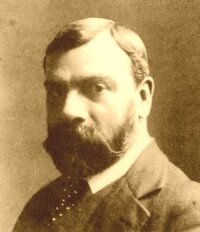
The Architects: E J May
Sandra Grant profiles Norman Shaw's successor, Edward John May
This article is also available in pdf format
 In 1882 Richard Norman Shaw wrote to Edward John May, one of his successors as a Bedford Park architect: "So you have tired of old Carr. I must look him up. I expect you have made at least twice as much out of the place as I have. Very glad to think it and to hear that you are driving such a devil of a trade."
In 1882 Richard Norman Shaw wrote to Edward John May, one of his successors as a Bedford Park architect: "So you have tired of old Carr. I must look him up. I expect you have made at least twice as much out of the place as I have. Very glad to think it and to hear that you are driving such a devil of a trade."
If E J May did manage to do well out of Jonathan Carr he would have certainly have surpassed the other architects employed by Bedford Park's founder. Like many developers, Mr Carr was constantly short of funds and spent much time ducking and diving to avoid his growing debts.
Edward May seems to have led a more blameless life. Born in 1853, in 1869 he became the last pupil of Decimus Burton (who designed the Palm House at Kew Gardens), studying at the Royal Academy architecture school. His veneration for his master extended to making a pilgrimage to Burton's old office every year for 50 years on the anniversary of his first arrival there.
Once his articles had finished he joined Richard Norman Shaw's practice as an assistant. He became part of an informal group of architects connected to Shaw, including the latter's former partner, William Nesfield.
Having been involved with Shaw's designs for Bedford Park, his appointment as estate architect after Shaw bowed out in 1880 seemed natural. With the development only partly built, Edward May took on the task of completing the 1ayout and designing some of the buildings.
To ensure better supervision, he moved into the neighbourhood, living at 6 Queen Anne's Grove until 1888 with his new wife and growing family – he eventually had six children. The ploy worked, since these parts of Bedford Park seem to be rather better built than earlier houses. He would certainly have been able to keep a careful watch on work on the terrace in Queen Anne's Grove, which he published in Building News as his own design.
Edward May was also responsible for the houses in Priory Gardens, including the pretty terrace with its unusual shell-shaped porches, the Vicarage (pictured right) and number one, now headquarters of the Victorian Society. He designed several houses in The Orchard, Addison Grove, Marlborough Crescent, Priory Gardens and 1 Newton Grove. Having taking over Shaw's drawings for the Club (now the Buddhist Vihara) on The Avenue, he later enlarged the building, adding a theatre.
According to Andrew Saint's hook on Norman Shaw, Edward May was a "considerable architect, an excellent draughtsman, and a charming and humorous man", yet his work after Bedford Park was disappointing.
It has been suggested that his drawings promised more than the buiidings which finally emerged. A sketching tour abroad in 1876 seems to have developed his talent for draughtsmanship, and while working for Shaw he won the Pugin Scholarship with his drawings.
Following his work in Bedford Park he developed a practice in Bloomsbury, designing houses in virtually every county in Britain. Among them were Jardine Hall near Dumfries, Barnsdale near Oakham, Swarland Hall, Northumberland and Kirklevington Grange in Somerset. For many years he was architect to the Church of England Waifs & Strays Society and one of his (unrealised) ambitions was to build a church.
After his death in 1941, his obituary in the Journal of the Royal Institute Of British Architects describes him as "not exactly retiring, being too full of life and fun to be shy. For him architecture to the end remained just an absorbing craft which, with his family and home, his garden and his deep religion, filled a most joyous life to the overflowing.
"Towards his pupils, assistants, clients and builders he was always the same unruffled master of himself, though in a quiet way he could be more severe than any blusterer. His fairness in every dealing was crystal clear, and his perpetual joy and interest in those around him revealed a master in the art of living."